Communication in Biological Systems: Biosignaling (Signal Transduction)
Introduction
 “Why communicate when we could just stare into our eyes while thinking of ramen ?” (License: Public Domain]:
Pixabay
“Why communicate when we could just stare into our eyes while thinking of ramen ?” (License: Public Domain]:
Pixabay Communication has shown a certain level of vitality in recent times. We see how an aero plane needs to stay in constant communication with its control tower in order to navigate the skies perfectly. We also see how important it is for us to stay in constant communication with our significant others to keep our relationships going. Communication is important and that is just about it.
There have been a lot of advances in the means we use to communicate. Back in the day, a letter had to be delivered across long distances either by foot or by use of camels, donkeys or horses. Birds like the pigeons also had to act as messengers sometimes. It took days, months and on some occasions, years, for messages to be passed across.
In recent times, however, this has changed. Messages can be sent in less than a second. Thank you, technology. One doesn’t even need to worry where a receiver is cause as long as there a medium for communication, messages will be sent.
Our cells however have chosen to maintain their ancient ways of communication. These means of communication by cells may be ancient but they can equally be as fast as modern means of communication. Cells communicate with a lot of materials and need to however stay in homeostasis. This means they need to choose accurately what materials to allow in and what materials to reject. It’s a constant struggle but this is what they live for.
Cells Have Ways To Receive and Act On Signals Beyond their Membranes.
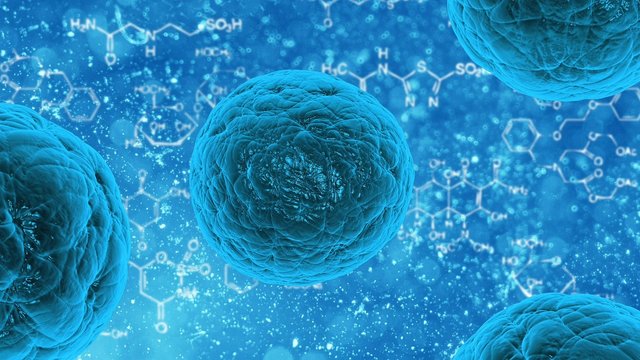 Hello, are you there ? (License: Public Domain]:
Pixabay
Hello, are you there ? (License: Public Domain]:
Pixabay Cells have devised ways to receive and act on signals that originate from beyond their plasma membranes (the barrier which separates a cell from its external environment), a process known as biosignalling. The cells possess special molecules that can interact with biological signals and induce corresponding change(s) within a cell. The pathway that involves the receiving of and acting on signals by cells is known as the signaling pathway and involves a lot of components.
First of all, for a cell to communicate with an external biological signal. It must possess a receptor. A biological signal isn’t like a transmission wave or a radio wave like you would expect. It is in form of a biological substance like a hormone or an amino acid derivative and in some cases, synthetic substances like drugs.
Specificity is a common requirement in biological systems so external signals like hormones must be a 100% fit of their receptors to be able to elicit a biological action(s). These external signals are collectively known as ligands . But this is not very accurate as light, odor and mechanical stress can also act as external signals but I choose to talk about ligands when referring to external signals in this article.
While ligands can be of many origins, receptors are of limited kinds. In biochemistry, the two most popular receptor types are; the G-protein coupled receptors and the Tyrosine Kinase receptors. These receptors have special mechanisms for transducing signals and this will be shown with time.
Ligands are of two types; Agonists and Antagonists. While the agonists bind receptors and elicit biological action, an antagonist binds to receptors without eliciting biological action as its main purpose is prevention of agonist binding.
The binding of a ligand to its receptor is important for a biological effect to take place. This statement implies that in a lot of cases, if there is no ligand binding then there’s no biological action. This is basically how drugs work. Drugs are tailored to specific receptors and only bind to those receptors causing biological effects to take place. This actually means that drugs do not introduce new actions in biological systems but rather alter an already existing physiological action (increasing or reducing).
How does The Signal Transduction Pathway Proceed in a Biochemical Sense
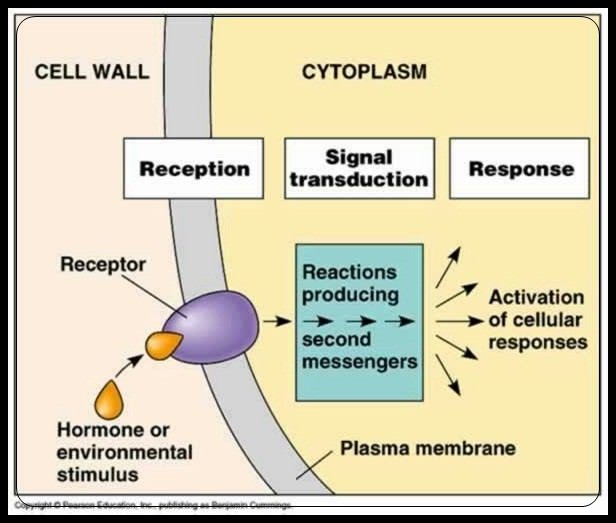 A schematic overview of the Signal Transduction pathway [License: CC-BY-SA 4.0, Author: Yaneeporn]:
Wikicommons
A schematic overview of the Signal Transduction pathway [License: CC-BY-SA 4.0, Author: Yaneeporn]:
Wikicommons A ligand first needs to bind to its receptor but this is not where it stops. There is a stereochemical interaction within this ligand-receptor entity for biological effects to be elicited. How the biological effect is elicited depends on the type of receptor. The effect is in most cases multiplied while moving along a signaling pathway. This makes it possible for very small molecules to exert huge biological actions.
The G-Protein Coupled Receptors
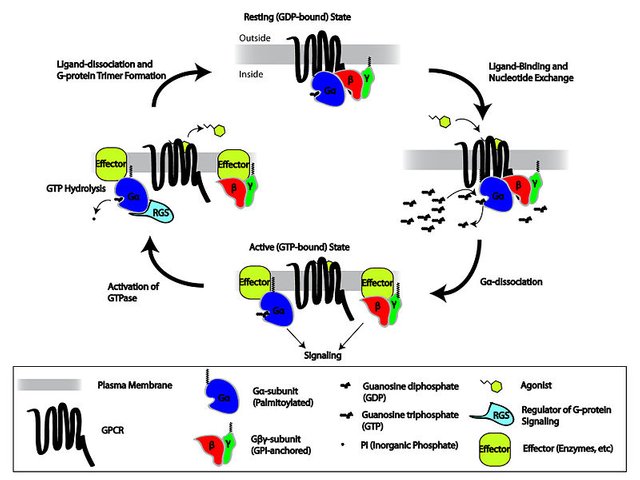 A schematic Representation of the G-protein Signaling pathway [License: CC-BY-SA 3.0, Author: Repapetilto]:
Wikicommons
A schematic Representation of the G-protein Signaling pathway [License: CC-BY-SA 3.0, Author: Repapetilto]:
Wikicommons For the G-protein coupled receptors, a g-protein unit is relevant for its action. The G-coupled receptor has attached to it, a G-protein made up of three subunits denoted by alpha, beta and gamma. The alpha-subunit of this G-protein unit when in an inactive state has a GDP molecule bound to it and it stays in association with its other subunits.
A G-Protein is Activated
When a ligand binds to a G-protein coupled receptor, a G-protein is activated. Activation of a G-protein involves replacing the GDP molecule attached to the G-protein alpha subunit with a GTP molecule. This causes the alpha subunit to dissociate from the beta and gamma subunits. This is relevant in allowing the alpha subunit carry out biological action. The remaining beta-gamma subunits can also carry out biological action and is also important in the overall G-protein signaling pathway.
Adenylate Cyclase is a Biological Target for The Activated G-protein.
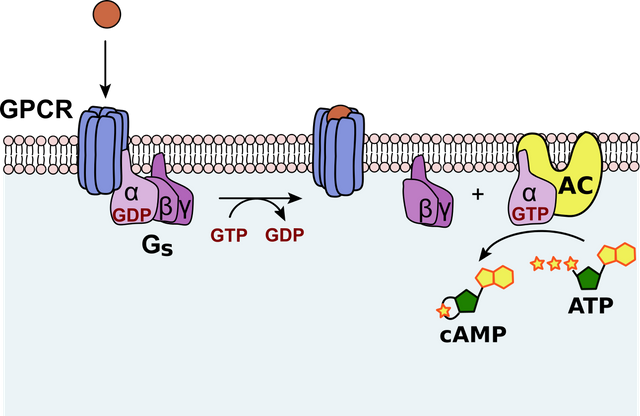 An illustration of how G-protein activates the Adenylate Cyclase System [License: CC-BY-SA 3.0, Author: Takanori Nakane]:
Wikicommons
An illustration of how G-protein activates the Adenylate Cyclase System [License: CC-BY-SA 3.0, Author: Takanori Nakane]:
Wikicommons The alpha subunit of the Activated G-protein often binds to an enzyme that is an integral component of some cell membranes. This enzyme is adenylate cyclase. Adenylate Cyclase catalyzes the conversion of ATP to cyclic adenosine monophosphate (cAMP). The cAMP assumes the role of a second messenger (the ligand is the first messenger) and activates another enzyme.
cAMP is known to activate kinases which catalyze the transfer of phosphoryl groups from one molecule to another. It activates a protein kinase known as Protein Kinase A. It does this by binding to the two regulatory subunits of protein kinase A which are always in constant association with its two catalytic subunits ultimately keeping it inactive. Binding cAMP frees up the catalytic subunits, activating protein kinase A consequently.
Protein Kinase A catalyzes the transfer of a phosphoryl group from ATP to the serine or threonine resides found in the active sites of specific enzymes. One of such enzymes is glycogen phosphorylase. Glycogen phosphorylase is the third messenger in this cascade. Glycogen phosphorylase as mentioned in my previous post catalyzes the breakdown of glycogen to glucose causing the release of glucose into blood or breakdown of glucose to produce energy.
The Flight, Fright or Fight Response: Using it to illustrate the G-protein Signalling Pathway.
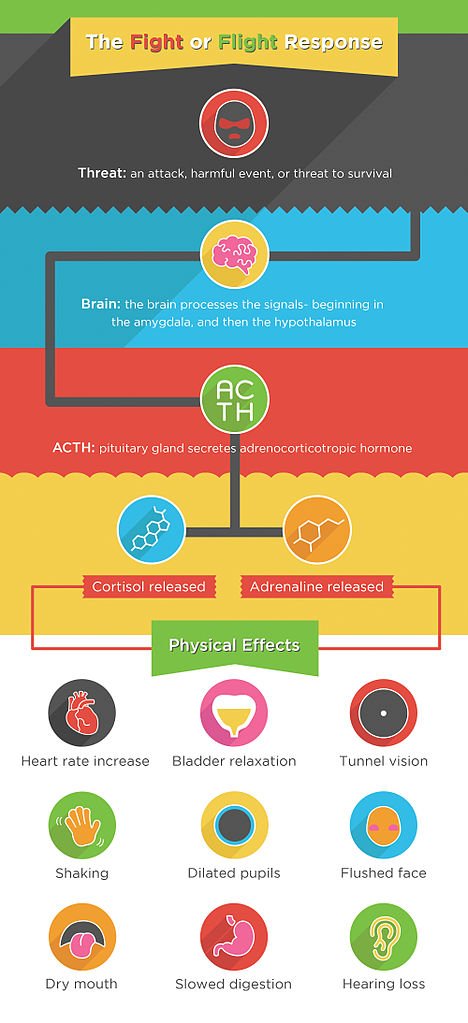 What happens during the flight or fight response [License: CC-BY-SA 4.0, Author: Jvnkfood]:
Wikicommons
What happens during the flight or fight response [License: CC-BY-SA 4.0, Author: Jvnkfood]:
Wikicommons During periods of extreme danger and stress, there is a large secretion of adrenaline which is commonly referred to as an adrenaline rush. A cascade of biochemical events occurs as result of this adrenaline rush. Adrenaline activates g-coupled receptors on muscles by sending signals via the nervous system leading to activation of a g-protein.
This activated g-protein binds to Adenylate Cyclase leading to the formation of cAMP. cAMP acts as a second messenger relaying the signal via activation of protein kinase A. Protein kinase A causes the phosphorylation of glycogen phosphorylase, ultimately, activating it.
The activated Glycogen phosphorylase can now cause the release of glucose from glycogen stores enabling it enter the glycolytic pathway providing energy for the processes like vasoconstriction of blood vessels, increased heart rate, increased activity of the brain, dilation of the pupils which are seen to occur during the flight, fright of fight response.
Switching off the G-protein Signaling Pathway: An Insight into The Reason Coffee Can Actually Keep You Awake
The G-protein signaling pathway gets turned off especially when the goal purpose of the pathway has been achieved. The question is, how is it done ?
For starters, The G-protein has GTPase activity so it can actually hydrolyse the GTP bound to it and become inactive.
cAMP can similarly be acted upon by a cAMP phosphodiesterase enzyme yield AMP and discontinuing the signaling pathway. What coffee does to keep you awake is by inhibiting this enzyme. The ultimate consequence is continuous production of cAMP and sustained action of protein kinase A and ultimately, glycogen phosphorylase. This causes stored energy supplying molecules to be mobilized into blood making you stay awake and not likely willing to sleep.
Receptor Tyrosine Kinases
 Receptor Tyrosine Kinases [License: CC-BY 4.0, Author: CNX OpenStax]:
Wikicommons
Receptor Tyrosine Kinases [License: CC-BY 4.0, Author: CNX OpenStax]:
Wikicommons Some receptors possess tyrosine kinase activity. This tyrosine kinase does what other kinases do, catalyzing the transfer of a phosphoryl group. Binding of a ligand to a receptor tyrosine kinase causes the two domains of this receptor to be phosphorylated. The receptors appear to have phosphorylated themselves and this is termed autophosphorylation.
Phosphorylation of the tyrosine kinase domains of these receptors lead to their activation causing them to phosphorylate other kinases in the signaling pathway. A ras signaling pathway is turned on in the course of this. ras is also a G-protein. Ras can be activated by attachment of a GTP molecule to it with a corresponding release of GDP. The Ras-GTP complex in turn catalyzes the transfer of phosphoryl groups from ATP to the serine or threonine residues found in subunits of kinases to continue the cascade. The ultimate target of the ras protein are nuclear proteins which bind to DNA and regulate (induce or repress) the expression of certain genes.
Switching Off the Ras protein: An Insight into the Mode of Progression of Cancer cells.
The Ras protein has GTPase activity so it can hydrolyze its GTP moiety, replace it with GDP and become inactive when its ultimate goal has been achieved. In cancer cells, the Ras protein is mutated and this mutated ras protein has a very low GTPase activity so the signaling pathway stays on. The signal could be in the aim of switching on or turning off a process but in the case of cancer cells, the signaling effect is excessive. The signaling pathway for growth stays on and so cells have to stay dividing and this presents as uncontrolled cell growth.
Not All Ligands Bind To Extracellular Receptors
Some ligands are hyprophobic/lipophilic so they can diffuse through the cell membrane easily. In case the above terms sound bizarre. Hydrophobia has to do with dislike for water and being lipophilic has to do with easy solubility in lipids. Some ligands have their receptors situated in the intracellular portion of the cell. Perfect examples are the glucocorticoids.
The receptors for these ligands have a portion for ligand binding and a portion for DNA binding. The ligand first binds to the receptor, then the ligand-receptor complex binds to DNA and alter gene expression. It is also important to note that neither the ligand nor receptor can bind solely to DNA on their own. This goes to buttress the need for interaction between a receptor and a ligand for a biological effect to take place.
Summary
Biosignaling is an important process in life. The ability of cells to receive and act of biological signals has proven useful in the implementation of various cellular processes. The pharmaceutical industry has also harnessed this concept of biosignaling by tailoring drugs that mimic the natural hormones of the body. Basically everything communicates and the cells are not any different.
References
Lehninger, A. L., Nelson, D. L., & Cox, M. M. (2000). Lehninger principles of biochemistry. New York: Worth Publishers. pp. 421-481.
Berg, J. M., TyMoczko, J. I & Stryer, L. (2002). Biochemistry (5th Edition). New York. W.H. Freeman. pp. 599-634.
Murray, R. K., Granner, D. K., Mayes, P. A. and Rodwell, V. W. (2003). Harper’s Illustrated Biochemistry. (26th Edition). Lange Medical Books. New York. pp. 466-484.
Pratt, W. C & Cornely, K. (2014). Essential Biochemistry. (3rd Edition). Wiley Publishers. United States of America. pp. 266-289.
Image Sources
All images are from pixabay and wikicommons licensed under creative commons and eligible for commercial use.
I'm a proud member of the steemstem community which promotes quality posts in the science, technology, engineering and mathematics fields on the steem blockchain mainly through interaction and engagement. Feel free to join us on discord here
This is what I refer to as an outstanding write up... Well detailed.
Of a truth biosignaling is the unique way through the biological system interact and the specificicty of drugs to target receptor site is really an advantageous one. Without specificity, it would be difficult for drugs,hormones and many biomolecules to interact with the body system.
Beautiful write up!
thank you for the honest comment man and yea, communication is very vital in biological systems
The scientist way of cell communication is just simply amazing.. I enjoyed my time on your article; although some parts got me thinking extensively; am not a science person @kingabash - but I get the message.
Hello @kingabesh
Just like the way enzyme substrates bind to surfaces, right? However, I just learnt a new thing here: that drugs don't introduce anything new to a biological system but bind to existing structures, altering them physiologically.
It is interesting to know that all these complex processes happen before communication can be effected.
Regards
@eurogee of @euronation community
ah yeah man, drugs just alter an existing physiological condition. cheers
✌️
Although I had a really hard time understanding most of those complex biological terms, I still really do appreciate the time and effort you put into researching this great piece of work. Well done man!
This is actually an awesome concept. It gives biologists and pharmaceutical practitioners the power try out many biological experiments using Biosignalling.
Nice work u've here buddy
I actually did not know this part in the mechanism of taking drugs. Thanks for sharing
Thank you guy, as a medical researcher, I enjoyed your great article.
This is a topic that has always fascinated me, cell talk.
To listen to the audio version of this article click on the play image.

Brought to you by @tts. If you find it useful please consider upvoting this reply.
@kingabash my mentor.
Quite an informative article.
The process of communication in other organism is quite a struggle mahn... You've properly explained this process. Great!!
thanks man. cheers